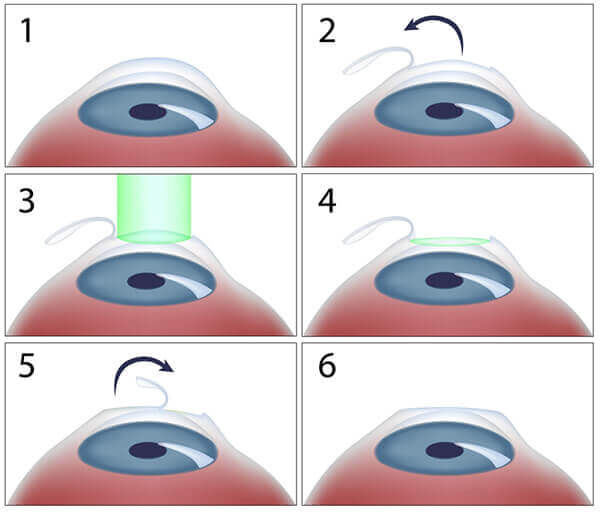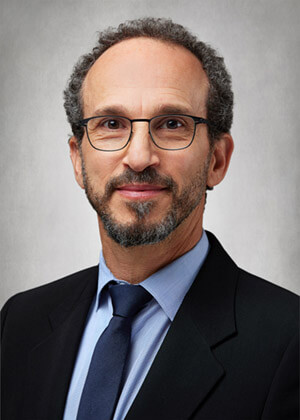LASIK
LASIK EYE Surgery in Boston
LASIK (Laser Assisted In-Situ Keratomileusis) is a vision correction procedure designed to treat nearsightedness, farsightedness and/or astigmatism. It offers many people the opportunity to greatly reduce or possibly eliminate the need for eyeglasses or contact lenses.
OCB is proud to be the first practice in Massachusetts to offer the next generation in Lasik technology. With the new iDesign Advanced Wavescan Studio System, which became available in 2018, our patients are getting better results than ever before.
Due to the increased precision in scanning and mapping the eye’s cornea and the higher resolution of the new imaging technology, patients stand a greater chance of not having to wear glasses, and even of seeing better than they could ever see with glasses.
In addition, this new advanced technology is FDA approved for a wider range of optical correction. So if you were not a candidate for LASIK in the past due to severe nearsightedness or astigmatism, you may now qualify for LASIK, thanks to the advanced iDesign technology. Schedule your consultation today!

What is iLASIK?
iLASIK is an advanced laser vision correction procedure that offers exceptional results with one of the safest laser vision correction technologies available today.
iLASIK offers blade-free, fully customized laser vision correction, custom tailored for each patient’s unique visual profile.
What Conditions Does iLASIK Treat?
iLASIK is approved for a broad range of vision disorders including:
- mild to severe nearsightedness
- mild to moderate farsightedness
- All types of astigmatism
For those seeking a premium laser vision correction procedure that offers one of the highest safety profiles available, iLASIK procedure is the clear choice.
How Does iLASIK Work?
iLASIK has several key technologies that make a significant difference in the quality and consistency of visual outcomes. The crown jewel of the customized iLASIK procedure is the new iDESIGN Advanced WaveScan Studio™ technology using the VISX™ Star S4 IR excimer laser system and Iris Registration.
LASIK Technology
iDESIGN Advanced WaveScan Wavefront Studio™
OCB is the first practice in Massachusetts to offer this smarter technology. Working like a computer “brain”, the iDESIGN System captures more data than ever before to create a picture of the eye’s unique imperfections and accurately plan treatments. This new system uses a high-definition sensor that has 5X the resolution of our previous CustomVue wavescan system, caputuring over 1,200 data points from each eye, providing an even more precise map of your eye’s anatomy, identifying your unique visual “fingerprint”. This allows your surgeon to further custom tailor your vision correction procedure to the exact curvature and microscopic hills and valleys of the eye. Due to this system, patients at OCB are getting outstanding results.
IntraLase™ FS (femtosecond) Laser
Your measurements guide the computer-driven IntraLase™ FS (femtosecond) Laser technology using the WaveScan™ Wavefront. This creates a customized laser driven corneal flap with micro-precision, while simultaneously preparing an optical corneal surface below the flap for better visual outcomes.
Iris Registration (IR)
Iris Registration provides a fully automated, non-contact, method of providing precise patient alignment and the WaveScan™ Wavefront measurements in preparation for the laser correction treatment.
This technology combination delivers truly customized vision correction based on the unique refractive signature of your eye.

LASIK Process
How Does LASIK Work?
Laser light is capable of performing surgical procedures too delicate for the finest scalpel. This makes laser light the ideal tool to use on the eye. The term “laser” is an acronym for “Light Amplification by Stimulated Emission of Radiation,” which is the scientific description of the method for creating this intense beam of light.
The excimer laser uses a mixture of argon and fluorine gases to produce a slender beam of invisible ultraviolet light energy. This ultraviolet light has a much shorter wavelength than the ultraviolet light in sunlight that causes sunburn.
The excimer laser does not burn the eye. It removes only 1/4 of a micron (an amount invisible even with a normal examining microscope, representing about one ten-millionth of an inch) of cornea with each pulse. The excimer laser energy first breaks up the molecular bonds in the cornea’s collagen connective tissue, and then scatters the small molecules into the air. This process is call photo-ablation.
In laser vision correction, the excimer laser is used to reshape the curvature of the eye so that light becomes focused crisply on the retina. This can reduce your dependency on glasses or contact lenses. The reshaping may be carried out in one of two ways: on the surface of the cornea, with photorefractive keratectomy (PRK), or under the surface of the cornea, with laser in-situ keratomileusis (LASIK).
Your LASIK Consultation
Preparing for Your LASIK Consultation
Please bring your current glasses, previous glasses or your contact lenses to the examination. Complete and bring the patient registration form and medical history form that was mailed to you. Do not wear soft contact lenses two weeks before the consultation or hard contact lenses for three weeks before your consultation. This will allow the surface of your cornea to resume its normal shape. Your eyes will be dilated during the examination; therefore you should bring sunglasses to assist you in driving home after the examination.
Your Consultation
Your LASIK consultation will include a comprehensive eye examination and special testing to design a treatment plan for your individual needs. The testing will include:
- A refraction (a measurement of the optics of your eye)
- A microscopic examination of your eye using corneal topography. This computerized image maps the curvature of the cornea (the top layers of your eye.) A corneal map is similar to a geological relief map (see example below). Each color represents a different steepness of curvature. Corneal Topography results are used to evaluate which procedure is best for you.
- A dilated refraction to verify your prescription
- A comprehensive discussion of your individual eye health and recommendations for your refractive laser surgery.
Scheduling LASIK Surgery
You will be able to schedule your laser surgery and post-operative exams with the Refractive Surgery Coordinator. You will then be given a laser surgery packet with all of the information needed for your surgery.
Preparing for LASIK
Beginning three days before your laser surgery, use all eye drop prescribed by your physician in the eye that is being corrected.
Read your Consent Forms and bring them with you on the day of your surgery. If you have any questions regarding your surgery please call your Surgical Specialist Team who will be happy to help. After your surgery you should expect to go home and rest quietly for the remainder of the day.
The LASIK Procedure
You will check in one-half hour prior to your scheduled surgery time. Upon arrival your Consent Forms will be signed and collected and you will receive your post-operative instructions for review. You will be called into an exam room to discuss your post-operative instructions and to answer any questions regarding surgery. You will then be given a mild sedative to help you relax.
When ready for surgery, the nurse will bring you to the laser surgery suite. You will remain awake and comfortable during the laser procedure. A numbing topical anesthetic drop will be put into your eye and you will be prepared for the laser treatment. The surgeon will then begin the LASIK procedure. This procedure will take approximately 10-15 minutes per eye, and you will remain lying comfortably on a reclining chair throughout the laser procedure.
When the surgery is complete, a nurse will escort you to the waiting room where you will rest for about 20 minutes. The surgeon will then examine your eyes and then you will be ready to go home. Please remember all patients need to be escorted home from the surgery. OCB will not release patients without escorts. You should plan to be at the Laser Center for 1-3 hours.
After LASIK
- For the first day and night, your eye will be protected with a clear plastic shield. The shield will stay on until your postoperative appointment the next day.
- Upon arriving home, sleep and relaxation for the eye are best for recovery.
- You will need to follow post-operative instructions for the eye drop medications beginning the day of your laser procedure.
- While most patients experience little or no discomfort after LASIK surgery, some do experience low to moderate pain.
- You will return to the doctor’s office the next day for your one-day post-operative exam. At this exam your shield will be removed and your vision measured. The vision will be improved but may remain partially blurry. You will begin to see noticeable results right after surgery. At your one-day exam you should have 70%-90% of the achievable vision.
- A schedule of post-operative and follow up appointments will be made for you. It is very important to carefully follow all medication and post-operative instructions and to attend all scheduled appointments.
- Please remember to be particularly careful to avoid having any foreign matter in the eye for at least two weeks. This includes avoiding soap and water in the eye (you may need assistance to wash your hair), do not wear eye makeup or other cosmetics around the eye, and do not swim or get water in the eye for at least two weeks.
- Eye protection should always be worn while participating in all heavy exercise, sports activities (including racquet and contact sports and golf), yard work and other outdoor activities with the potential for eye injury.
- You will then be able to begin a lifestyle with the freedom of new vision.
Side-Effects & Complications of LASIK
As with any type of surgery, complications are possible. Every effort is made to minimize risks, but serious or long-term complications can never be fully eliminated. Common side effects after refractive surgery include:
- Glare from bright light sources, such as oncoming headlights while driving at night may occur but generally improves and often resolves over the first six months after the procedure. In a few cases, patients use eye drops to keep the pupil small, thereby reducing glare.
- Light sensitivity may rapidly improve over days to weeks; however, a few individuals have ongoing light sensitivity for six months or longer.
- Shadowing, doubling of vision, or “ghost images” usually resolves on its own, but sometimes need further re-treatments.
- Variable vision may occur depending upon the procedure for weeks to months after the procedure. Some individuals experience a small fluctuation in the precise focus over the course of the day. This daily fluctuation generally subsides during the month after the surgery.
- Overcorrection and under correction may occur in some patients. if you feel that the uncorrected vision is not as good as desired, you may require the use of glasses, contact lenses, or further laser procedures.
No list of complications can be complete. Any medical or surgical procedure has innumerable potential risks, both foreseen and unforeseen. If you have additional concerns, please ask your surgeon.
Our LASIK Team
The physicians at Ophthalmic Consultants of Boston have been at the forefront of pioneering research and development of LASIK technologies. Since OCB’s inception, our physicians have been successfully helping patients achieve better vision through LASIK. Today, LASIK is one of the most popular elective treatment options offered at OCB.
We invite you to learn more about our OCB specialists, LASIK or other available vision correction services.
The surgeons at Ophthalmic Consultants of Boston (OCB) are comprised of leading ophthalmic specialists in the field of LASIK and refractive surgery.
Dedicated to providing you with the most advanced techniques and the highest level of patient care, our physicians, along with their skilled health care teams, are there to guide you in determining if you’re an ideal candidate for vision correction services, offered at our Waltham location.

